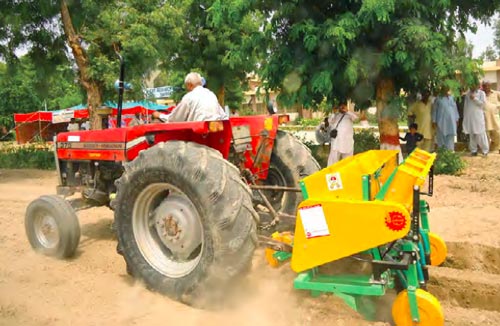CIMMYT, in collaboration with Wheat Research Institute Sindh (WRIS) and Pakistan Agriculture Research Council (PARC) supported by USAID, initiated pilot testing of a multi-crop bed planter for planting cotton and wheat in a cotton-wheat cropping system in Sakrand, Pakistan under the Agricultural Innovation Program (AIP) for Pakistan.
Dr. Imtiaz Hussain, cropping systems agronomist, explained how the multi-crop bed planter is used for planting various crops such as cotton, maize, pulses, rice and wheat on raised beds. This planter will help farmers cut farming operations and costs. It can be used to make beds, plant crop and apply fertilizer in one operation in a cotton-wheat cropping system.

A field day was organized by WRIS on 27 August for the stakeholders to observe bed planted cotton, a demonstration of a bed planting operation, and discuss its use and performance. Over 150 new and aspiring farmers, agriculture extension workers, agriculture researchers and representatives from private seed companies observed the planting of mung beans using the multi-crop bed planter in the field.
Badar ud Din Khokahar, agronomist at WRIS, spoke about his experience with this new technology, noting the bed planted cotton had better germination and plant population in comparison with conventionally ridge planted cotton. The ability to apply fertilizer close to plant resulted in better crop growth.
The field day was followed by a discussion forum, where the participants expressed their interest in this new and emerging technology. During this session, farmers showed appreciation for the introduction of a multi-crop bed planter and showed their interest in using the planter for wheat crop next season. In response, Dr. Kareem Laghari, director at WRIS, recognized the efforts and cooperation of CIMMYT in the introduction of new technologies, and ensured that this technology will be transferred to the farmers for wheat and cotton planting.
Dr. Atta Somoro, director general Agriculture Research Sindh, acknowledged CIMMYT’s efforts in wheat research in the country and especially in the Sindh province. He recognized how CIMMYT’s work in the Green Revolution is highly valued. He also mentioned that the continuous inflow of germplasm and technologies from CIMMYT has helped to improve wheat productivity.
Dr. Shahid Masood, member of Plant Sciences within the Pakistan Agricultural Research Council (PARC), recognized how the efforts of CIMMYT and the support of the U.S. Agency for International Development (USAID) are very helpful in scaling up mechanized planting in this area, which will ultimately help to improve crop productivity, along with saving in water and improving fertilizer use efficiency.
Dr. Imtiaz Muhammad, country representative CIMMYT-Pakistan, informed the participants that AIP is focusing on improving the productivity of the wheat and maize through better germplasm, seed and better agronomy. The project focuses on increasing agricultural productivity and incomes in the agricultural sector across Pakistan, with more emphasis on smallholder farmers from provinces with less access to agricultural resources. This equipment will be tested and it will also be manufactured locally through this project, so that more and more farmers can benefit from these activities.
 Capacity development
Capacity development 
